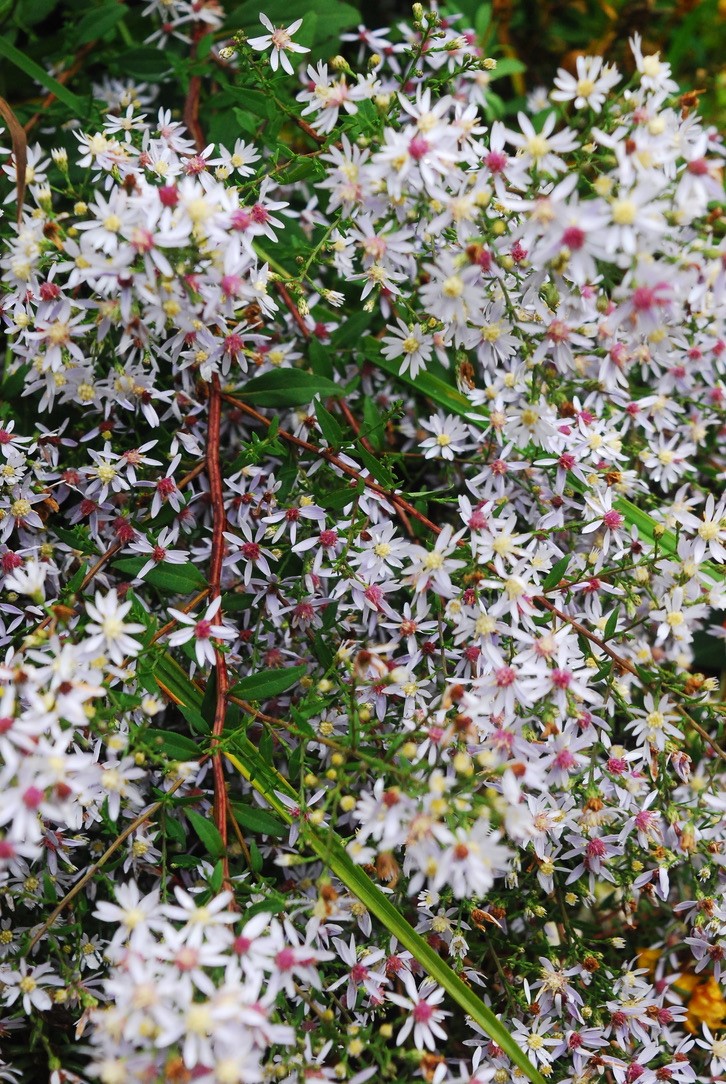Native Plants : Stops for Birds & Butterflies
By Rhea Hamilton-Seeger
Why plant native plants?
Why plant native plants? Good question! Our birds and insects have set diets and they readily recognize the sources of their food. Yes they love some of the annuals and our traditional perennials but need the rich pollen and nectar of native plants for the right balance of nutrition. Native plants provide sources of berries and seeds for birds, both the ones that spend the winter here and the ones migrating. Think monarch butterflies and their plight looking for food sources on their flight south. And again on the route north in the spring. Or returning songbirds finding no insects nestled in the leaves for spring feast.
For a variety of reasons native plants have been quickly disappearing in the landscape. Even the roadsides and hedgerows that once offered sustenance are now either cut, sprayed or simply removed. Both scientists and naturalists have been recording the drop in population of birds and insects and in some cases complete loss of valuable pollinators.
But as gardeners we do have an opportunity here to help turn the situation around. By planting native plants and leaving them standing we not only offer the food throughout the year but also valuable shelter for the winter.
Native plants are enjoying a surge in popularity and if enough communities dedicate strips in the gardens and in municipal areas we can see a change; more butterflies, more bees and more birds.
Where does one start? A lot of gardeners already grow coneflowers and fall asters.
There are 75 species of asters in North America. The Michaelmas daisy or New England aster is the most readily identified with its height and prolific clusters of purple blooms late in the season. Great pollinator magnets, as are the wee white ones, heath aster, that we see as clouds along the roadsides. They pop up and bloom late, offering great foraging for insects readying them for winter hibernation in the leaves and long grass.
The next trick is to not cut down any native plants in the fall, preferring to leave them standing as a food source for wintering birds and shelter for pollinators. Finches love grazing in the crowns of seed heads, especially goldenrod.
Coneflowers, Echinacea purpurea, are especially striking and can be readily picked out in many gardens. We are more familiar with the pink or pale purple but there is also a yellow variety. As the name indicates the flower is a central cone and a flutter of drooping petals around the base. Their leaves are rough, and become smaller towards the top of the plant. It starts blooming mid summer and continues through to fall. What is not to like about that?
While they do well in hot and dry conditions, they prefer a bit of moisture in dry seasons. You can shake the seed heads around the base of the plant and gently ruffle the soil to encourage seedlings in the spring!
Another treasure is Indian Pink (Spigelia marilandica). Even in November this sweet plant may set out wee red buds. What a worker. When happy it can grow from 60 to 70 cm (24-28 inches) tall. It requires more than four hours of sun. It has dark red tubular flowers with yellow interiors and reblooms sporadically through the fall.
The last native plant that would fill the show ticket and help with our pollinators is Baptista,or indigo blue. Last fall I started a pot of dark blue ones from seed I found in a landscape garden. I did not mark the pot and it took me a few days in the spring to realize what they were. It pays to mark the seeds you plant in the fall.
The next big question is which is best for our pollinators, the native varieties or the hybridized versions? Hybridized plants offer gardeners more choices in colour and size. Some plants are bred for compactness to avoid the need to stake plants in small gardens.
The science is still out on which provides better nutritional value for the pollinators, the natives or the hybridized plants. We know that bees, butterflies and other insects prefer a landing zone to get at the nectar. More petals impedes that so bear that in mind when picking out new plants for your garden.
One last point on planting native plants for pollinators. It pays to think about how our pollinators get around. Grouping like-plants together saves a lot of flying time and energy. Now if we could just get swathes or even small patches in each of the neighbour’s gardens we would all see more bees and butterflies in our gardens.
If you are looking at selecting the best native plants for your area, a good resource can be found at Pollinator.org , a wonderful site with resources that target specific areas. I downloaded their Guide for Gardeners, Farmers, and Land Managers in the Manitoulin-Lake Simcoe. It covers Manitoulin, south to below Stratford and as far east as Kingston. It outlines briefly the lay of the land and then dives into ‘meeting the pollinators’ before offering ideas for incorporating farmland, public land and home landscapes into pollinator friendly habitat.
Calico Aster Symphyotrichum lateriflorum



